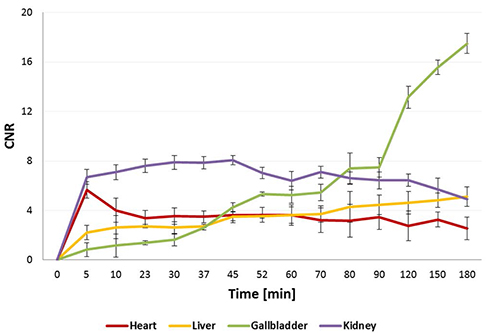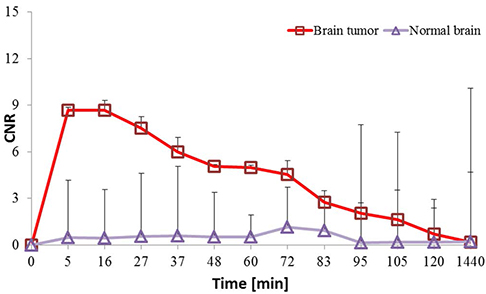Investig Magn Reson Imaging.
2019 Mar;23(1):34-37. 10.13104/imri.2019.23.1.34.
In vivo Imaging Biodistribution Profile of a New Macrocyclic Gadolinium Chelate as a Highly Stable Multifunctional MRI Contrast Agent
- Affiliations
-
- 1Department of Medical & Biological Engineering, Kyungpook National University, Daegu, Korea. ychang@knu.ac.kr
- 2Hana Pharm Co., Pangyo R&D Center, Seongnam-si, Korea.
- 3Department of Molecular Medicine, School of Medicine, Kyungpook National University, Daegu, Korea.
- 4Department of Radiology, Kyungpook National University Hospital, Daegu, Korea.
- KMID: 2442231
- DOI: http://doi.org/10.13104/imri.2019.23.1.34
Abstract
- Gadolinium contrast agents (CAs) are integral components of clinical magnetic resonance imaging (MRI). However, safety concerns have arisen regarding the use of gadolinium CAs, due to their association with nephrogenic systemic fibrosis (NSF). Furthermore, recently the long-term retention of Gd²âº-based CAs in brains patients with normal renal function raised another possible safety issue. The safety concerns of Gd²âº-based CAs have been based on the ligand structure of Gd²âº-based CAs, and findings that Gd²âº-based CAs with linear ligand structures showed much higher incidences of NSF and brain retention of CAs than Gd²âº-based CAs with macrocyclic ligand structure. In the current study, we report the in vivo biodistribution profile of a new highly stable multifunctional Gd²âº-based CA, with macrocyclic ligand structure (HNP-2006). MR imaging using HNP-2006 demonstrated a significant contrast enhancement in many different organs. Furthermore, the contrast enhanced tumor imaging using HNP-2006 confirmed that this new macrocyclic CA can be used for detecting tumor in the central nervous system. Therefore, this new multifunctional HNP-2006 with macrocyclic ligand structure shows great promise for whole-body clinical application.
MeSH Terms
Figure
Reference
-
1. Geraldes CF, Laurent S. Classification and basic properties of contrast agents for magnetic resonance imaging. Contrast Media Mol Imaging. 2009; 4:1–23.
Article2. Grobner T. Gadolinium--a specific trigger for the development of nephrogenic fibrosing dermopathy and nephrogenic systemic fibrosis? Nephrol Dial Transplant. 2006; 21:1104–1108.
Article3. Marckmann P, Skov L, Rossen K, et al. Nephrogenic systemic fibrosis: suspected causative role of gadodiamide used for contrast-enhanced magnetic resonance imaging. J Am Soc Nephrol. 2006; 17:2359–2362.
Article4. Kanda T, Fukusato T, Matsuda M, et al. Gadolinium-based contrast agent accumulates in the brain even in subjects without severe renal dysfunction: evaluation of autopsy brain specimens with inductively coupled plasma mass spectroscopy. Radiology. 2015; 276:228–232.
Article5. Broome DR. Nephrogenic systemic fibrosis associated with gadolinium based contrast agents: a summary of the medical literature reporting. Eur J Radiol. 2008; 66:230–234.
Article6. Kim HK, Lee GH, Chang Y. Gadolinium as an MRI contrast agent. Future Med Chem. 2018; 10:639–661.
Article7. European Medicines Agency. PRAC concludes assessment of gadolinium agents used in body scans and recommends regulatory actions, including suspension for some marketing authorisations. 2017.8. Gu S, Kim HK, Lee GH, Kang BS, Chang Y, Kim TJ. Gd-complexes of 1,4,7,10-tetraazacyclododecane-N,N',N'',N'''-1,4,7,10-tetraacetic acid (DOTA) conjugates of tranexamates as a new class of blood-pool magnetic resonance imaging contrast agents. J Med Chem. 2011; 54:143–152.
Article9. Narita M, Hatano E, Arizono S, et al. Expression of OATP1B3 determines uptake of Gd-EOB-DTPA in hepatocellular carcinoma. J Gastroenterol. 2009; 44:793–798.
Article
- Full Text Links
- Actions
-
Cited
- CITED
-
- Close
- Share
- Similar articles
-
- The Effects of Rotational Correlation Time of Paramagnetic Contrast Agents on Relaxation Enhancement: Partial Binding to Macromolecules
- Successful Angioplasty of Arteriovenous Graft Obstruction Using Gadolinium chelate in a Patient with Iodine Hypersensitivity
- Anaphylactic Shock Due to Gadolinium Based MRI Contrast Agent
- Dynamic Contrast-Enhanced MRI and Its Applications in Various Central Nervous System Diseases
- Prevention of Nephrogenic Systemic Fibrosis





